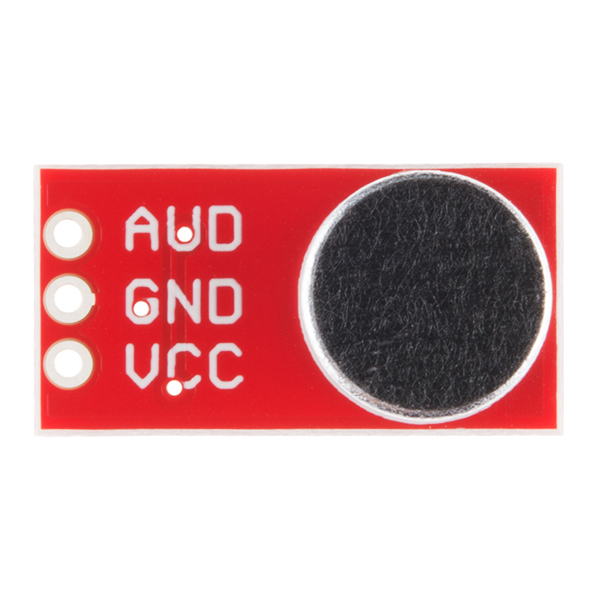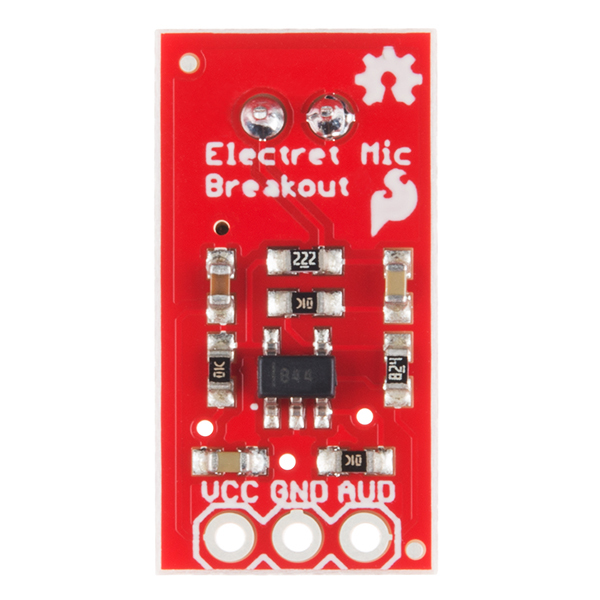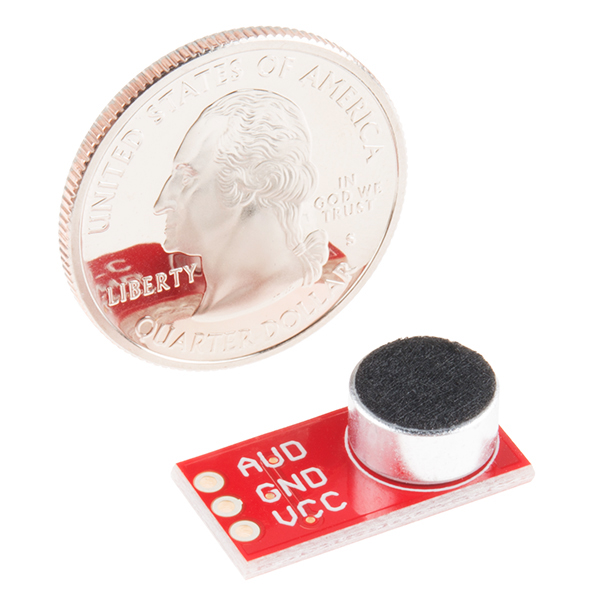SparkFun Electret Microphone Breakout
This small breakout board couples an Electret microphone (100Hz--10kHz) with a 60x mic preamplifier to amplify the sounds of voice, claps, door knocks or any sounds loud enough to be picked up by a microcontroller’s analog-to-digital converter. Each breakout comes fully assembled and works from 2.7V up to 5.5V.
The Electret Mic Breakout translates amplitude (not volume) by capturing sound waves between two conducting plates (one a vibrating diaphragm and the other fixed) in the microphone and converting them into electrical waves. These electrical signals are then amplified and picked up by your microcontroller’s ADC.
- Schematic
- Eagle Files
- Hookup Guide
- Datasheet (OPA344)
- Datasheet (Mic)
- GitHub
SparkFun Electret Microphone Breakout Product Help and Resources
Dot/Bar Display Driver Hookup Guide
January 16, 2014
How to hook up the LM3914 or LM3916 to drive a 10-LED display with a lone analog signal.
Electret Mic Breakout Board Hookup Guide
June 23, 2016
An introduction to working with the Electret Mic Breakout Board.
Vox Imperium: Stormtrooper Voice Changer
October 25, 2016
Add some flair to your Imperial uniform by changing your voice using a Teensy 3.2 and Prop Shield.
Audio Codec Breakout - WM8960 Hookup Guide
January 26, 2023
The SparkFun Audio Codec Breakout - WM8960 is a low power, high quality stereo codec chock full of features. In this tutorial, some of these features by using an Arduino microcontroller to configure the audio codec and pass audio to the headphone or speaker channels.
Core Skill: Soldering
This skill defines how difficult the soldering is on a particular product. It might be a couple simple solder joints, or require special reflow tools.
Skill Level: Noob - Some basic soldering is required, but it is limited to a just a few pins, basic through-hole soldering, and couple (if any) polarized components. A basic soldering iron is all you should need.
See all skill levels
Core Skill: Programming
If a board needs code or communicates somehow, you're going to need to know how to program or interface with it. The programming skill is all about communication and code.
Skill Level: Noob - Programming will be limited to basic drag and drop interfaces like ModKit or Scratch. You won't be writing code, but you will still need to understand some basics of interfacing with hardware. If you?re just using a sensor, it's output is analog.
See all skill levels
Core Skill: Electrical Prototyping
If it requires power, you need to know how much, what all the pins do, and how to hook it up. You may need to reference datasheets, schematics, and know the ins and outs of electronics.
Skill Level: Rookie - You may be required to know a bit more about the component, such as orientation, or how to hook it up, in addition to power requirements. You will need to understand polarized components.
See all skill levels
Comments
Looking for answers to technical questions?
We welcome your comments and suggestions below. However, if you are looking for solutions to technical questions please see our Technical Assistance page.
Customer Reviews
4.4 out of 5
Based on 7 ratings:
1 of 1 found this helpful:
Easy to use. Sensitive
As a "Mr. Wizard" experiment with the kids we set out to measure the speed of sound. Previous attempts used a firecracker to interrupt/allow a laser beam, because a very loud noise was needed to detect the arrival of the sound. With the electret microphone breakout I was able to easily detect the sound of a popping balloon. Now I can do the experiment legally and accurately.
John Gardner
1 of 1 found this helpful:
Higher sensitivity than the MEMS microphone
Developed a white noise system for our Advance Physics Lab for the students to explore.long data sampling. Have several different diameter tubes with different lengths and placed a speaker at one end that is powered by a white noise generator and the other end the SparkFun Electret Microphone Breakout that is then connected to digital oscilloscope. The digital oscilloscope takes a long data record 2-Mega-points and an FFT is performed to find the resonant frequency of each of the tubes. The SparkFun Electret Microphone Breakout worked very well for this and will be using it in more labs.
Did not work for me
Not enough range. Not sensitive enough.
Works great
I added this board to my Cajon to help mic it. Simple and works amazing. The added circuitry for signal boost is a huge bonus.
Does the job nicely
Simple but effective little breakout. I also reduced the gain on one and took out the mic and bias resistor to create a line-input circuit amp. Thanks for making life a little easier guys.





I've seen the different projext presented as exemple, and knowing that there's one working with voice recognition, can we use this component to create a violin tuner ?
Can I perform voice recognition from the signals received?
Can someone please let me know if this can be used to detect heart sound? And how can this be used to pass data via bluetooth?
What is the Output Impedance of this? Will it work if connected directly to a PC Soundcard? How about the Electret Microphone itself?
Can this be used as a drop-in replacement for adafruit's model (https://www.adafruit.com/product/1063)?
I don't see why not - we do use a different op-amp for the pre-amplifier and we do not have selectable gain. Our specs a slightly different...just depends on your application and your gain requirements.
How do i configure this to pick up only small breathing sounds? It seems like once I make a sound it keeps logging the knock knock even if I have the volts >= 2.0 && volts <= 3.0
For an application this specific I'd recommend you use the SparkFun Sound Detector
Is the output centered on 0?
no, note the bias V on non-inverting OA input pin. So will be referenced to approx 1/2 of Vcc.
How is this different from BOB-09964?
This is a revision of that product. They still have the same function but the revision has an updated filter for better performance. There is also a tutorial with a couple example projects and more projects to follow in early July.
Got it, thanks! I'm always curious what's different when there's a new revision of a product.